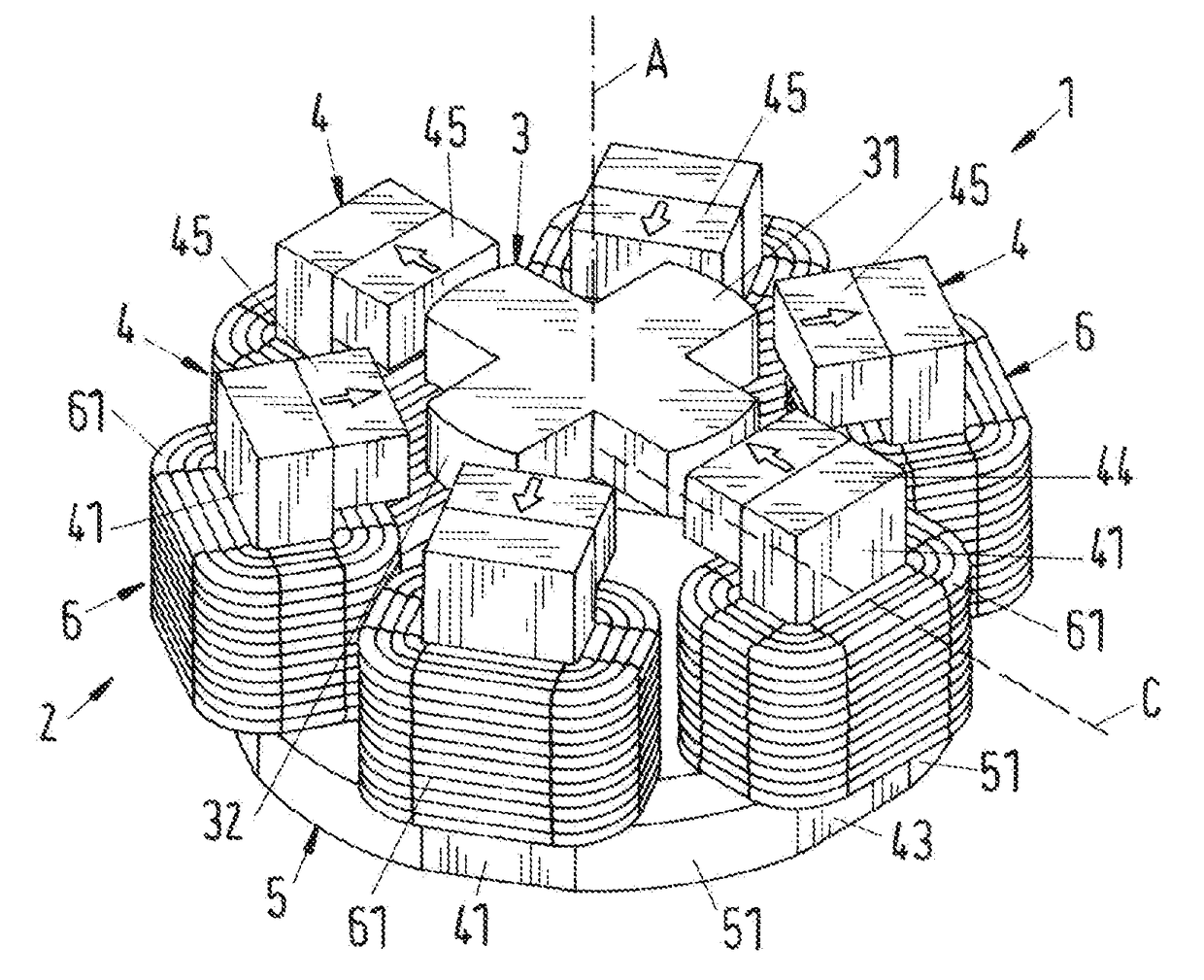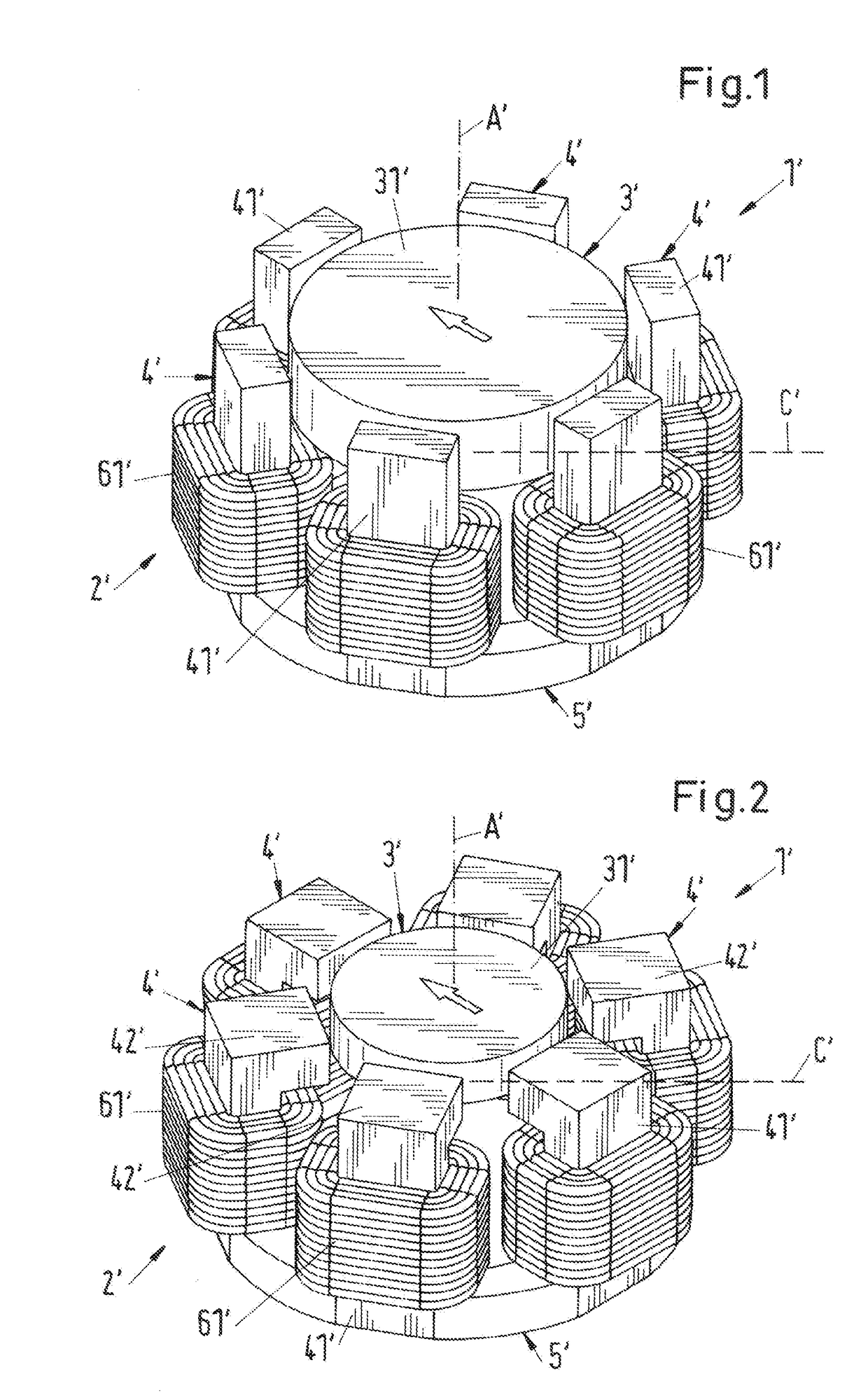Electromagnetic rotary drive and rotational device
- Summary
- Abstract
- Description
- Claims
- Application Information
AI Technical Summary
Benefits of technology
Problems solved by technology
Method used
Image
Examples
first embodiment
[0091]The stator 2 furthermore comprises a plurality of windings 6 for generating an electromagnetic rotational field. The windings 6 are here configured as individual coils 61 of which each surrounds one of the longitudinal limbs 41. This means that the axes of the coils 61 each extend in parallel with the axial direction A. In the first embodiment shown in FIG. 4, each longitudinal limb 41 supports exactly one coil 61.
[0092]It is therefore a further feature of the temple motor 1 that the coils 61 of the stator 2 are arranged outside the magnetic rotor plane C, beneath the magnetic rotor plane C in accordance with the representation. The coils 61 are preferably arranged completely beneath the magnetically effective core 31. The coils 61 are therefore not arranged in the plane in which the rotor 3 is driven and supported in the operating state. Unlike other electromagnetic rotary drives in which the coils of the stator are arranged such that the coil axes each lie in the magnetic ro...
second embodiment
[0121]A total of six coil cores 4 are also provided in the second embodiment and surround the rotor 3 in a circular form and equidistantly. The number of six coil cores 4 is to be understood as exemplary in this respect. A different number of coil cores 4 can naturally also be provided, for example eight or twelve or four coil cores 4, wherein an even number of coil cores 4 is preferred for technical regulation reasons. A number of six or eight or twelve coil cores 4 has proven advantageous for many applications.
[0122]FIG. 7 shows a preferred third embodiment of the rotary drive 1 in accordance with the invention in a perspective representation. For better understanding, FIG. 8 shows a section through this third embodiment in the axial direction. In the following, only the differences from the above-described embodiments will be looked at. The reference numerals in particular have the same meaning as has already been explained in connection with the embodiments described above. It i...
third embodiment
[0123]In the third embodiment, each coil core 4 comprises a transverse limb 42 that is arranged at the second end 44 of the respective longitudinal limb 41 and that extends in the radial direction, that is perpendicular to the axial direction A and thus perpendicular to the respective longitudinal limb 41. In the embodiment of the electromagnetic rotary drive 1 shown in FIGS. 7 and 8 as an internal rotor, the transverse limbs 42 extend inwardly, that is toward the rotor 3, in the radial direction. It is understood that in an embodiment of the rotary drive 1 as an external rotor (see e.g. FIG. 18), the transverse limbs 42 each extend outwardly, that is again toward the rotor 3, in the radial direction.
[0124]Each coil core 4 thus has an L-shaped embodiment, wherein the longitudinal limbs 41 form the long limb of the L that extends in the axial direction A and the transverse limbs 42 that extend perpendicular to the longitudinal limbs 41 toward the rotor 3 in the radial direction form ...
PUM
 Login to View More
Login to View More Abstract
Description
Claims
Application Information
 Login to View More
Login to View More - R&D
- Intellectual Property
- Life Sciences
- Materials
- Tech Scout
- Unparalleled Data Quality
- Higher Quality Content
- 60% Fewer Hallucinations
Browse by: Latest US Patents, China's latest patents, Technical Efficacy Thesaurus, Application Domain, Technology Topic, Popular Technical Reports.
© 2025 PatSnap. All rights reserved.Legal|Privacy policy|Modern Slavery Act Transparency Statement|Sitemap|About US| Contact US: help@patsnap.com



